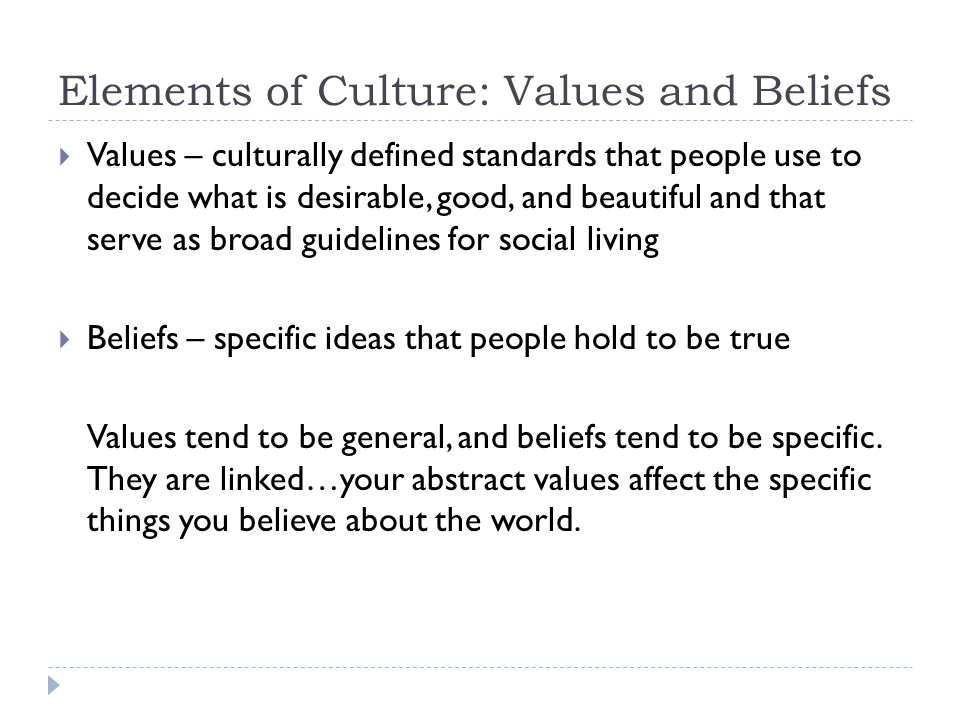Relevance: Sociology

The first, and perhaps most crucial, elements of culture we will discuss are its values and beliefs.
What are values?
Values are a culture’s standard for discerning what is good and just in society. Values are deeply embedded and critical for transmitting and teaching a culture’s beliefs.
What are beliefs?
Beliefs are the tenets or convictions that people hold to be true. Individuals in a society have specific beliefs, but they also share collective values. To illustrate the difference, Americans commonly believe in the American
Dream—that anyone who works hard enough will be successful and wealthy. Underlying this belief is the American value that wealth is good and important.
How do Values play role in Society?
Values help shape a society by suggesting what is good and bad, beautiful and ugly, sought or avoided. Consider the value the culture the United States places upon youth. Children represent innocence and purity, while a youthful adult appearance signifies sexuality. Shaped by this value, individuals spend millions of dollars each year on cosmetic products and surgeries to look young and beautiful. The United States also has an individualistic culture, meaning people place a high value on individuality and independence. In contrast, many other cultures are collectivist, meaning the welfare of the group and group relationships are a primary value.
Why Living up to a culture’s values can be difficult?
It’s easy to value good health, but it’s hard to quit smoking. Marital monogamy is valued, but many spouses engage in infidelity. Cultural diversity and equal opportunities for all people are valued in the United States, yet the country’s highest political offices have been dominated by white men.
Values often suggest how people should behave, but they don’t accurately reflect how people do behave. Values portray an ideal culture, the standards society would like to embrace and live up to. But ideal culture differs from real culture, the way society actually is, based on what occurs and exists. In an ideal culture, there would be no traffic accidents, murders, poverty, or racial tension. But in real culture, police officers, lawmakers, educators, and social workers constantly strive to prevent or repair those accidents, crimes, and injustices. American teenagers are encouraged to value celibacy. However,
the number of unplanned pregnancies among teens reveals that not only is the ideal hard to live up to, but that the value alone is not enough to spare teenagers from the potential consequences of having sex.
How do Society ensures the fulfilment of Values?
One way societies strive to put values into action is through rewards, sanctions, and punishments.
When people observe the norms of society and uphold its values, they are often rewarded. A boy who helps an elderly woman board a bus may receive a smile and a “thank you.” A business manager who raises profit margins may receive a quarterly bonus. People sanction certain behaviours by giving their
support, approval, or permission, or by instilling formal actions of disapproval and non-support.
Sanctions are a form of social control, a way to encourage conformity to cultural norms. Sometimes people conform to norms in anticipation or expectation of positive sanctions: good grades, for instance, may mean praise from parents and teachers.
When people go against a society’s values, they are punished. A boy who shoves an elderly woman aside to board the bus first may receive frowns or even a scolding from other passengers. A business manager who drives away customers will likely be fired. Breaking norms and rejecting values can lead to cultural sanctions such as earning a negative label—lazy, no-good bum—or to legal sanctions such as traffic tickets, fines, or imprisonment.
Values are not static; they vary across time and between groups as people evaluate, debate, and change collective societal beliefs. Values also vary from culture to culture. For example, cultures differ in their values about what kinds of physical closeness are appropriate in public. It’s rare to see two male friends or coworkers holding hands in the United States where that behaviour often symbolizes romantic feelings. But in many nations, masculine physical intimacy is considered natural in public. This difference in cultural values came to light when people reacted to photos of former president George W. Bush holding hands with the Crown Prince of Saudi Arabia in 2005. A simple gesture, such as handholding, carries great symbolic differences across cultures.

What are Norms?
Norms define how to behave in accordance with what a society has defined as good, right, and important, and most members of the society adhere to them.
Formal norms are established, written rules. They are behaviours worked out and agreed upon in order to suit and serve the most people. Laws are formal norms, but so are employee manuals, college entrance exam requirements, and “no running” signs at swimming pools.
Formal norms are the most specific and clearly stated of the various types of norms, and the most strictly enforced. But even formal norms are enforced to varying degrees, reflected in cultural values.
For example, money is highly valued in the United States, so monetary crimes are punished. It’s against the law to rob a bank, and banks go to great lengths to prevent such crimes. People safeguard valuable possessions and install antitheft devices to protect homes and cars. A less strictly enforced social norm is driving while intoxicated. While it’s against the law to drive drunk, drinking is for the most part an acceptable social behaviour. And though there are laws to punish drunk driving, there are few systems in place to prevent the crime. These examples show a range of enforcement in formal norms.
There are plenty of formal norms, but the list of informal norms—casual behaviours that are generally and widely conformed to—is longer. People learn informal norms by observation, imitation, and general socialization. Some informal norms are taught directly—“Kiss your Aunt Edna” or “Use your napkin”—while others are learned by observation, including observations of the consequences when someone else violates a norm. But although informal norms define personal interactions, they extend into other systems as well. Think back to the discussion of fast food restaurants at the beginning of this chapter. In the United States, there are informal norms regarding behaviour at these restaurants.
Customers line up to order their food, and leave when they are done.
They don’t sit down at a table with strangers, sing loudly as they prepare their condiments, or nap in a booth. Most people don’t commit even benign breaches of informal norms. Informal norms dictate appropriate behaviours without the need of written rules.
For more such notes, Articles, News & Views Join our Telegram Channel.
Click the link below to see the details about the UPSC –Civils courses offered by Triumph IAS. https://triumphias.com/pages-all-courses.php

